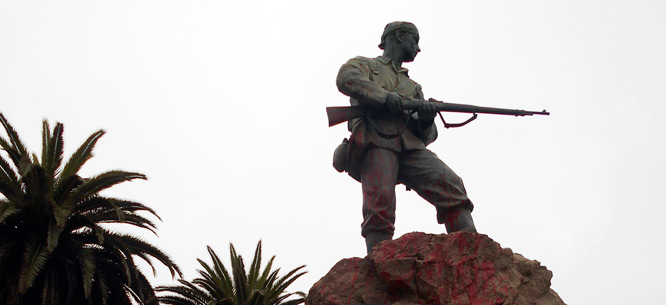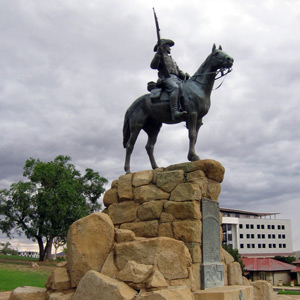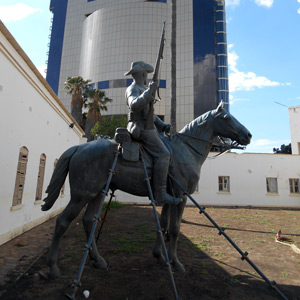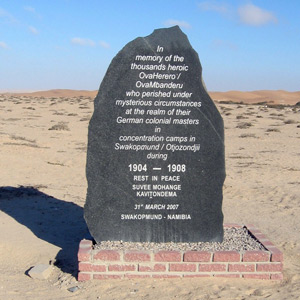Namibia’s Monuments to Genocide
Namibia’s Monuments to Genocide
In many Namibian cities, monuments to the twentieth century’s first genocide still stand, and have become a key battleground for activists demanding reparations from Germany for its colonial-era crimes.

Early last year, a group of activists splashed blood-red paint on a statue they saw as a monument to white supremacy and racial oppression. The statue was not in Louisiana, or Alabama, or Mississippi, but in Swakopmund, Namibia. It depicts a German soldier standing tall, rifle in hand, and another German soldier fallen below. Known as the Marine Denkmal, the statue commemorates Germany’s brutal suppression of an uprising by Namibia’s native Herero and Nama people against colonial rule, beginning in 1904. By 1907, German troops had killed up to 80 percent of the Herero community and an estimated 50 percent of the Nama community, in what many historians regard as the twentieth century’s first genocide. The Marine Denkmal was erected only a year later, in 1908.
Like their confederate analogs in the United States, colonial-era monuments in Namibia have lately been the subject of heated controversy. Amid these often acrimonious debates, relatively little attention has been paid to the ways in which such memorial controversies open up opportunities for more productive discussions of the past, for an acknowledgement of the suffering of others and for broader understanding across longstanding divisions. In the southwestern corner of the African continent, Namibians’ difficult path in seeking to engage the crimes of colonialism and genocide suggest the opportunities presented by memorial debates as well as their limitations. Activists in the United States might benefit from opening their own dialogue to their counterparts abroad.
The Marine Denkmal is hardly the only prominent memorial in Namibia to commemorate the power and reach of the country’s former European colonizer. The Reiterdenkmal (equestrian monument) stood in a prominent spot, high on a hill overlooking the capital, Windhoek, for almost a century. Unveiled in 1912 in honor of the birthday of German Kaiser Wilhelm II, near the German fort and on the site of a wartime concentration camp, it was erected by the colonial power as a symbol of the longevity of its rule. While the German forces in Namibia were defeated in the First World War, only a few years after the memorial was erected, the monument to colonial victory remained.
In 2008, when it became clear that government of now-independent Namibia planned to move the Equestrian to make way for a new independence museum, controversy erupted. While many walked by without paying much attention to the bronze sculpture, for some it was a crucial reminder of the past and their place in Namibia today. Interestingly, the statue was defended not just by descendants of the German settlers, as one might expect, but also by some whose ancestors suffered greatly under colonial rule. A number of leading Herero politicians, both in government and in opposition parties, argued that the horse should not be moved as it served as a daily reminder of German colonial-era crimes. For activists, the monument stood for the demand that the German government must publicly acknowledge the genocide and pay reparations. In 2008, Deputy Local and Regional Minister Kazenambo Kazenambo, speaking in his personal capacity, defined the demand for reparations as a “tsunami” that could not be stopped.
On August 19, 2009, the Reiterdenkmal was carefully moved as journalists and onlookers captured the moment. In early 2010, it was re-erected approximately 200 feet away in front of the Alte Feste, the old German colonial fort. But the old colonial monument soon stood in the way of plans for another new memorial. So it was moved again—this time, however, under the cover of darkness on Christmas Day. Police were on hand to close off the area. The memorial had proven to be too controversial and too polarizing to move again in public.
While the clandestine move elicited public criticism, the two new statues that have since been unveiled have generally been well received. On the original site stands a statue of the country’s first democratically elected president, Sam Nujoma, holding the constitution high above his head for all to see. On the second site, where the horse and rider stood more briefly, stands a memorial to those killed and those who survived the genocide. The Equestrian is still accessible, but in order to view the statue, the visitor now must step inside the dusty old colonial fort. The monument, previously dominating the city from its high pedestal, now seems shrunken, standing on the ground in the shadow of the new Independence Memorial Museum. While there is no plaque near the horse and rider explaining its historical significance, it is depicted inside the museum as a symbol of colonial rule.
 |
 |
 |
The moving of the Equestrian and the addition of new postcolonial memorials has not laid longstanding controversies to rest. Debate over how best to address the history of colonialism and genocide continue. The German government has, after much delay and pressure, publicly acknowledged that its predecessors engaged in genocide. A formal apology is expected soon, after months of discussions between special envoys appointed by the governments of Germany and Namibia, respectively. The German government has worked to keep any discussion of reparations off the table. Instead, it has offered special aid programs. Herero and Nama activists continue to demand reparations through the courts and through creative protests around memorial sites, putting pressure on the Namibian government to negotiate more forcefully with Germany.
Like their counterparts in Windhoek, the activists who poured red paint on the Marine Memorial in Swakopmund tie the presence of the memorial to unaddressed colonial crimes. Swakopmund town councilor and Ovaherero elder Uahimisa Kaapehi has condemned the German government’s resistance to any form of reparations. He says that activists and their children will continue the campaign for another century if necessary, and argues that reparations would not just serve as a powerful precedent for other African countries that suffered under colonial rule, but would also mean that “even when these superpower countries are attacking Libya, Iraq, Afghanistan . . . [they will know that] these people, even after one hundred years, will also stand up [and demonstrate] that what you did, was not according to the law.” This presumably is just the kind of precedent that Germany and other major powers including the United States seek to avoid.
While German reparations to Namibia remain unlikely, the ongoing attention to Herero and Nama demands have drawn far greater attention to the genocide and other colonial-era crimes. Activists have suggested that the Swakopmund memorial might be shipped back to Germany or be placed inside the local museum. Neither seems likely in a town where a prominent building still advertises the old name for the main street, Kaiser Wilhelm Strasse, instead of Sam Nujoma Avenue. But, even in this town known for its colonial nostalgia, demands to reckon with the past have become louder and bolder. Just a decade ago, members of the Ovaherero and Ovambanderu communities erected a memorial stone in the Swakopmund cemetery that noted the “mysterious circumstances” under which tens of thousands of Herero died in the “realm of their German colonial masters.” Today, the circumstances under which people died are far less mysterious. This is one small victory for activists in a long campaign that many still hope will grow into an unstoppable tsunami.
Elke Zuern is a professor of politics at Sarah Lawrence College.




